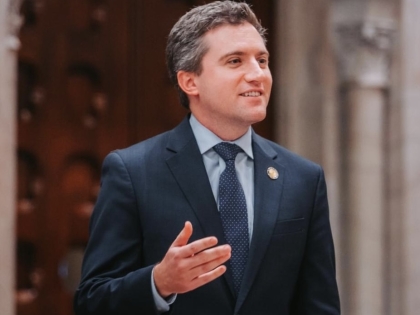
State Campaigns Are About to Rake in Public Dollars — and Spend All the Private Money They Want

At his campaign headquarters in Flushing, Queens, Assemblymember Ron Kim has been collecting small amounts of cash. Neighbors in his district give his campaign $5, $10, or $20 at a time. And because the six-term incumbent is taking advantage of New York’s new public matching program for state elections, each of these small contributions could be matched by as much as $12 in public financing for every dollar donated.
Kim’s rivals are also benefiting from the program, which matches contributions of up to $250 from district residents. An outspoken member of the Assembly’s left flank, he is facing at least two potential challengers in the June Democratic primary election. One of them, medical supply company owner Yi Andy Chen, has submitted donations that stack up to $150,000 with the public match.
That’s comparable to Kim’s matchable haul. But Chen has far outstripped Kim in donations that are too big to match: the former has reported more than a hundred donations of $1,000 and up. As of mid-March, Chen’s campaign totaled $227,000, more than double Kim’s war chest. Meanwhile, area voters are getting bombarded with super pac mailers that scream: “say no to socialist ron kim!”
Kim’s situation highlights a controversial aspect of the new campaign finance system’s design: There is no limit to how much participating campaigns can spend outside the program — so candidates can benefit from small-dollar matching and big-donor spending at once.
By contrast, New York City’s decades-old public finance system does impose a strict spending cap. And while the city program faces scrutiny under multiple corruption scandals — including straw donor schemes in support of Mayor Eric Adams — the state model will not audit the majority of campaigns, a condition the legislature set when it approved the program.
The money involved is substantial: The new state budget provides $100 million for matching funds, nearly one-third of the total that New York City has given candidates in the 36-year history of its system.
“You have candidates who try to exploit the campaign finance system while spending their own and independent expenditure money to try to buy elections, which defeats the purpose of having a democratic matching system in the first place,” said Kim.
The program’s architects argue that they left the cap out intentionally — to help candidates in the face of major independent spending. According to Joanna Zdanys, senior counsel for elections and government at the Brennan Center for Justice, the choice was a necessary concession to the realities of Citizens United, the 2010 U.S. Supreme Court decision that allowed unlimited outside spending in all elections.
Because of Citizens United, campaigns need “to spend against independent expenditures and to compete against candidates with deep-pocketed donors,” she told New York Focus and the city. A cap like New York City’s would tie candidates’ hands, the reformers decided.
Kim is nonetheless unsure how to counter the mailers from the Committee on Sensible Government, a right-wing super pac not affiliated with either challenger’s campaign.
The mailers threaten that Kim will “defund the police,” “eliminate school safety,” “make Flushing a red light district,” and “release criminals without bail.”
State records show the group is primarily funded with $100,000 from Ronald Lauder, the Republican activist who financed the high-stakes lawsuit that struck down congressional lines drawn by state Democrats. One of the committee’s registered administrators is Michael Nussbaum, a Democratic political consultant who publishes the Queens Daily Eagle.
New York’s new public matching funds system attempts to give candidates without big spenders in their corner a chance to make an impression, and its proponents say it’s working. They point to candidates like Claire Cousin, a Columbia County superviser running to unseat Assemblymember Didi Barrett and one of 328 potential legislative candidates enrolled in the program. Her campaign is powered by small donors, like a yoga teacher who gave $108 (which could yield $1,112 in public dollars), a clerk typist who gave $50 (worth $600), and a housekeeper who gave $10 (worth $120). Barrett is not participating in the matching program and has bigger donors, many whom donated the maximum amount of $3,000, and pac contributions from the insurance and energy industries.
“Working people like me haven’t had a fair chance against candidates with bigger donors historically, especially not against well-funded incumbents like my opponent,” Cousin said in a statement to New York Focus and the city. “That’s because we’re not usually tapped into the same networks of donors that can invest heavily in our campaigns, and because progressives like me refuse to take donations from corporate interests. So when I can tell my neighbors who are living paycheck to paycheck that their $5 donation is actually going to be $65, it’s huge.”
Well resourced as his campaign is, Chen conveys much the same message about power of the new government dollars. “I believe that the public matching system equalizes the political landscape and ensures every voter and individual has an equal voice, and not disregarded because of their ranging ability to monetarily contribute to a campaign as compared to larger donors,” he said.
“Fundraising is simple. When people believe in you and your vision, they will support,” Chen added. “My campaign fundraised a diverse mix of in district and out of district, in state and out of state donors who very simply, are daring for change.”
But some candidates are questioning the new system. Among them is Assemblymember Robert Carroll of Brooklyn, an experienced election lawyer who has sponsored reforms to ease voter registration but opted not to sign up for the matching funds program.
“There should be meaningful spending caps,” Carroll said in an interview. “There should be more meaningful limits to the contributions.”
Another critic is Micah Lasher, Governor Kathy Hochul’s former policy director who is now running for an Assembly seat on the Upper West Side.
“It seems like a pretty glaring flaw in the program to not pair a spending limit with a generous public matching funds program, and that is something that should be fixed,” said Lasher. In under three months, he raised enough in-district small donations to unlock the maximum $175,000 in public matching funds — the first candidate in the state to do so.
Lasher stands to reap serious benefits from the absence of a cap: In all, he has $250,000, including from influential donors in former Mayor Mike Bloomberg’s inner circle like Merryl Tisch, Dan Doctoroff, Emma Bloomberg, and Bradley Tusk, who each gave the maximum $3,000.
The city system uses the matching funds to lure candidates into agreeing to limit their spending, which levels the playing field, Lasher told New York Focus and the city. But as for the state program, he said, “I do not understand what the public policy rationale would be to not make candidates make that agreement.”
According to New York Democratic Party Chair Jay Jacobs, former Governor Andrew Cuomo’s pick to lead the commission in charge of the state program, the current model is the result of a balancing act between opposing interests.
“We were hearing from a lot of different people. We were trying to craft something that would be effective,” Jacobs said.
The state's fledgling public finance campaign gets underway as the city program is under fire. Several Adams donors are alleged to have made — or have admitted to making — contributions under other people’s names to unlock more matching dollars. (Neither Adams nor his campaign have been charged with wrongdoing.) And Brian Benjamin, former New York lieutenant governor, awaits a federal trial in connection with a matching funds scheme in his 2021 run for city comptroller.
The state is taking a notably more relaxed approach to auditing. Every city campaign has to go through a rigorous post-election audit, but under the state law, only one in three legislative campaigns can be subject to one in any cycle. There is an exception for when a candidate receives more than $500,000 in matching funds — a sum above the maximum an Assembly candidate could possibly get in a primary and general election combined.
The ease of accessing funds has come under scrutiny by incumbent lawmakers who are now pressing for changes to the program midway that would serve to protect them from challengers. Those changes would revive many of the proposals included in a bill Hochul vetoed last session.
“It is too easy to tap into public money for a campaign,” said state Senator James Skoufis, the lead sponsor of a bill that would make some substantial changes to the program. “These are taxpayer dollars. It should not be that you can just snap your fingers and get money from the sky.”
Half of the Senate Democratic conference — from democratic socialist Julia Salazar to Simcha Felder, who wins most of his votes on the Republican line — has signed onto the bill, which would raise the dollar and donor minimums needed to qualify for the program. It would also raise the bar for determining when a race is competitive and therefore eligible for public matching funds.
Felder’s own fundraising is a case in point for just how easy it is under current rules to qualify for matching funds.
Felder, who represents heavily Orthodox Jewish communities in Brooklyn, has won re-election by large margins for over a decade, pulling 95 percent of the vote in 2022. When the breakaway Independent Democratic Conference formed an alliance with Republicans to maintain gop control of the Senate, Felder was a reliable ally and often a swing vote.
His seat is as safe as they come. Yet Felder has signed up for the public matching funds program, and he is fundraising carefully to maximize his public dollars: Most of his donations come from residents of the district, either in contributions of $250 (the maximum matchable amount) or $5 (the minimum).
Under current program rules, if the Public Campaign Finance Board deems his race “competitive” — a threshold that can be met if a rival gets an endorsement from any group with more than 150 members — all registered candidates will be entitled to matching dollars. If it doesn’t, simply having anyone else on the ballot for the primary or general election would still entitle Felder to 25 percent of the matching funds.
He wins either way — by eliminating the competition or being rewarded for having it.
Felder’s campaign did not respond to an inquiry.
“It becomes free money you don’t actually need. You get a windfall against really nonviable candidates,” said a political consultant. “If you are an incumbent, there is absolutely no reason not to participate.”
The advent of a public matching system follows other major reforms spurred by public corruption scandals. They include the end of the “llc loophole,” which allowed virtually limitless contributions from corporate donors, and a vast reduction of contribution limits for legislative campaigns.
But the campaign finance program was birthed in a round of political bargaining that also made it harder for third parties to get on the ballot in New York, dooming the Libertarian, Green, and Independence parties. The program’s first year will be a test of whether generous public financing brings more choices for voters and a broader spectrum of candidates — and will indicate the extent to which it will make rich campaigns richer.
“Remember,” Jacobs said, “this was a compromise between groups that really wanted a full-fledged campaign finance system and those that didn’t want any campaign finance system.”
